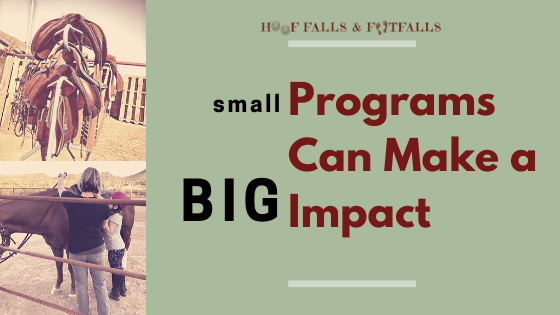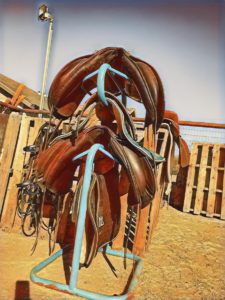A word of encouragement to the adaptive riding barns and programs that feel "too small" to make a big difference.....
Don’t make the mistake of thinking that BIG BARN (and an assumed big budget) = BIG IMPACT and small barn = small impact. BOTH large and small barns and programs have the potential to have a little or a lot of impact.
You don’t have to have a large barn or EAAT (Equine Assisted Activities and Therapies) program to be professional and make a big impact.
Smaller barns and programs matter and can make HUGE difference in the lives of the people they serve.
I spent a decade at a large premier accredited center and now I am literally a “backyard barn” (as my horses, barn and arena share a fence with my house’s back yard). I went from overseeing and interacting over a hundred participants a week (not including parents, volunteers, tours, etc) and personally teaching 20+ students a week to now capping out at ten private students a week.
I’m not going to lie…when I stepped away from the large program because of life changes I was worried how I could still make an impact. How in the world could I still make a difference if I was working with a fraction of the people?
It took me a while to get my bearings and find my place in a smaller scaled setting, One thing that helped me feel settled was deciding that although where I teach has physically gotten smaller, I don’t use the size or location of my barn to be an excuse to provide anything less than top quality services.
Whether you are at a big or little barn, certain things go a long way to making what you offer professional or sub par. It’s not always …..actually it’s usually not….the covered arena, high dollar tack, or expensive horses that set you apart from other places or people.
Things that can help YOU make a BIG impact no matter the size of your barn or program:
- Cleanliness– Are things clean and tidy? What impression do people get when they first walk through their gates? Are you demonstrating good facility maintenance and equine management to your students when they return each time? (check out this article on 5 Habits for a Clean Barn)
- Organization– Is there order (which helps maintain the tidiness mentioned above) or is there chaos? Organization is a great way to look professional and create less stress by having things laid out in an easy to understand way. (Take a look at this article that has some DIY organization tips.)
- Instructor attire– Swapping from a t-shirt to a button down or polo can make a difference. Are you dressing the part? Are you “looking” like the quality of instructor you really are and are asking your students to pay for?
- Heat is not an excuse! I love the Kerrits Ice Fil short and long sleeve shirts. They have been the best summer shirts that even stand up to the Arizona, triple digit summers!
- How You Conduct Yourself– How and what we say matters…and this includes what we say about other people. Do you use appropriate and professional language? Do you verbalize the positives and avoid complaining to other coworkers and your students? Do you talk kindly about others even if you don’t agree with everything they may do?
- How You Treat Your Horses– Hopefully no explanation needed. Treat your horses well by caring for not only their bodies but also their mind. Challenge yourself to always be learning more about equine care and maintenance so you can be the best two footed coworker to your four hooved coworkers.
- Training of Your Horses– How do they act on the ground and under saddle? You don’t need an expensive horse to have a good horse. Continue striving to keep learning more about equine training, behavior, and psychology so you can set your horses up for success. Having well trained horses, both on the ground and in the saddle, speaks incredibly loud about the quality and safety of your program.
- Communication– To students, volunteers, parents, etc. Are you clear in communicating and maintaining your expectations and policies that impact your students, volunteers, and coworkers? Are you clear in communicating schedules and any changes to the usual routine? (Check out this article that has 15 Keys to Effective Client Communication)
- How You Teach– This should not change no matter where you teach….small or large program. Are you giving your best during each class? Are you constantly pushing yourself to learn new techniques and grow through professional feedback? (learn more about Adaptive Riding Instructor Coaching HERE or learn some new techniques through continuing education in The Intuitive Instructor Club)
- Timeliness– Start and end on time to respect your client’s time and your time!
What things do YOU do that give your barn or program a professional look and feel? Comment below! I'd love to hear!

** I personally chose to use the term Adaptive Riding vs. Therapeutic Riding and avoid ‘horse therapy’ at all costs. Why? CLICK HERE. The thoughts shared in the post above apply to not only Adaptive riding but also to other mounted equine activities and therapies offered at an EAAT (Equine Assisted Activity and Therapy) Program/Center/Barn.


